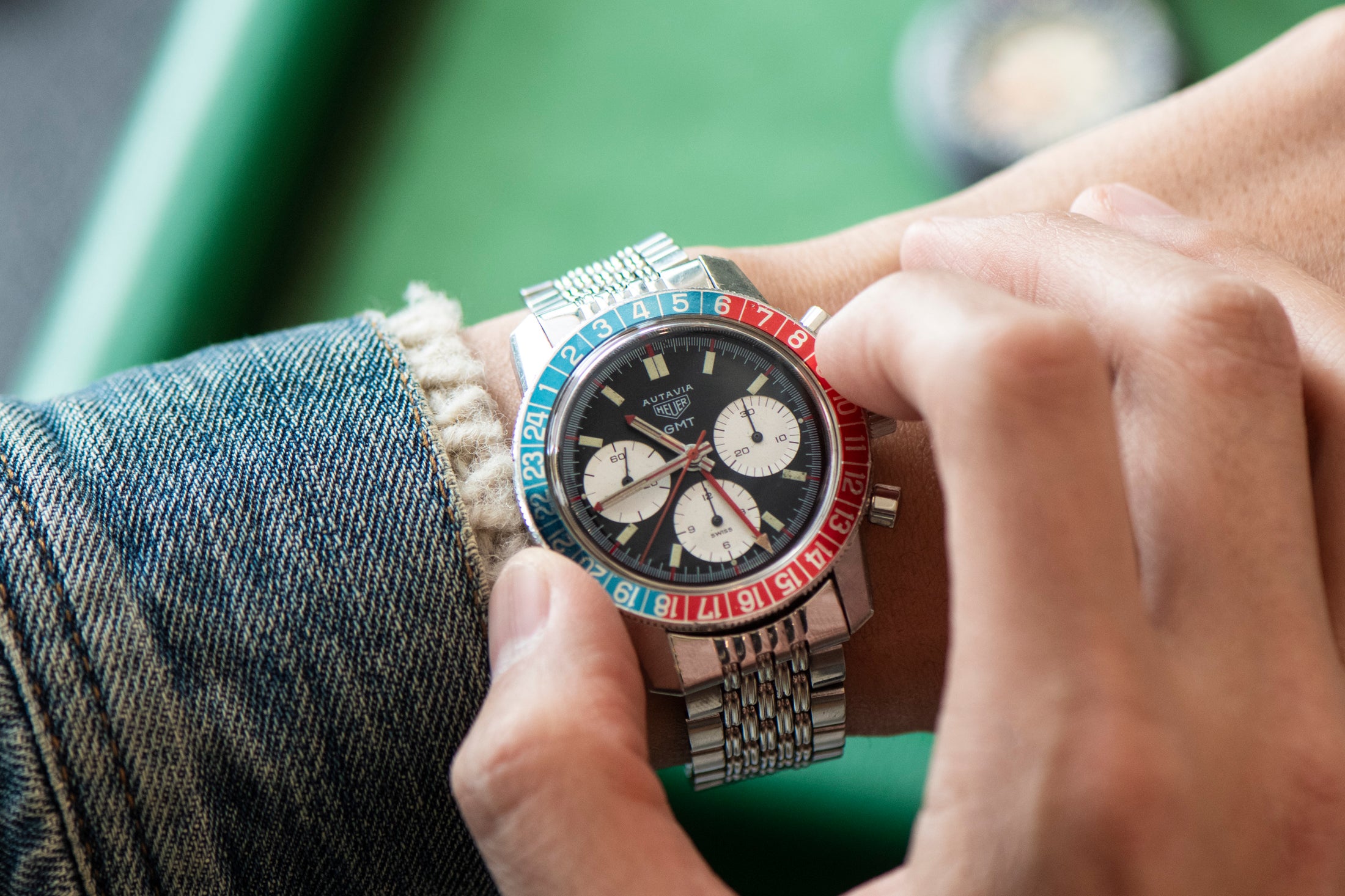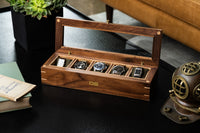Though we take them for granted today, the idea of a rotating (or fixed) watch bezel offering useful timing information is a relatively new innovation.
Before the 1950s, chronographs incorporated timing scales on the dials themselves, and dive watches (such as they were) didn’t yet have bezels. While rare exceptions to this rule, such as the Rolex Reference 3346 Zerographe from 1937, did indeed have external bezels, it was really the advent of recreational SCUBA diving and the proliferation of the automobile in the post-War environment that brought about new horological innovations, which included creative new tool watches with useful timing scales.
When many collectors first begin their collecting journey, they aren’t necessarily aware of what these bezels are used for. Actually, scratch that — many seasoned collectors still aren’t aware of what these bezels are used for! Some of them, filled with tiny typefaces and barely legible indices, appear needlessly complicated. Thus, we thought it might be a good idea to help decipher them for the horologically curious, and who knows — maybe the next time you’re screaming down the track, or producing widgets in a factory, or timing your descent to an ancient shipwreck, you’ll finally have the chance to use that pesky bezel on your shiny new watch…
Dive Bezel (aka ‘Count-Up’)

Tudor Pelagos Blue - IN THE SHOP
Perhaps best encapsulated by the Rolex Submariner, the dive bezel (or ‘count-up’ bezel) is used to calculate the elapsed time since the occurrence of a discrete event. While SCUBA diving, for instance, one might need to know how much bottom time has elapsed, or how much time has passed during a safety or other decompression stop. (These days, this functionality is largely taken care of by a dive computer, but for several decades, the mechanical watch was a life-saving piece of equipment.)
On this type of bezel, minutes 0-60 are displayed beginning at 12 o’clock, generally represented by a luminous pip, and increase clockwise. Originally, these bezels lacked a click spring, and were thus bi-directional; modern versions, however, are unidirectional, and can only be rotated counterclockwise — this safety feature prevents the user from accidentally under-calculating bottom or deco stop time, thus allocating more time underwater to what is actually allowable given the constraints of a fixed amount of air. (I.e. a diver cannot, using this system, accidentally nudge the bezel clockwise, which might lead him to believe that only 5 minutes have elapsed when 10 have in fact gone by.)

To use this bezel, one rotates it to the left until the 12 o’clock pip lines up with the minute hand — wherever it may currently be given the time. Once this is done, he or she can easily see how much time has passed, in minutes, since the bezel was rotated. If, for example, the time is 10:20, one would rotate the pip until it pointed to the 20-minute index. At 10:25, one could thus easily see that five minutes have elapsed, rather than needing to remember the time in order to calculate the elapsed interval.
Besides its function in SCUBA diving, the dive/count-up/elapsed time bezel is also supremely useful in everyday life. Need to time some pasta on the stove? Laundry in the dryer? The time-out you just put your five-year-old in after throwing a temper tantrum? Boom! Easy peasy. Most dive watches still incorporate the dive bezel, though non-dive timepieces also make use of it.
Countdown Bezel

DOXA Army Watches of Switzerland Edition - IN THE SHOP
The countdown bezel, as the name suggests, allows the user to count down until the beginning of a discrete event. Rather than progressing upwards from 0-60 in a clockwise manner along the bezel, this type progresses downwards from 60-0, and is often bidirectional. Found often on pilot’s watches, it’s a useful tool for calculating legs between waypoints, though it can be used to calculate time remaining until any conceivable event.

To use a countdown bezel, one simply turns it until the desired time period aligns with the minute hand. For example, in order to measure 10 remaining minutes, one would turn the bezel until the ‘10’ index aligns with the watch’s minute hand, wherever it happens to be. If it’s pointing to, say, 32 minutes, the bezel would thus show the "0" pip at 42 minutes, indicating that 10 minutes have passed.
GMT Bezel

HEUER Autavia GMT - IN THE SHOP
This type of bezel incorporates a 24-hour scale that’s used in conjunction with a 24-hour hand on the watch dial; generally bidirectional, it allows the user to quickly and easily track the time in a second time zone, effectively turning a single watch into two. The Rolex GMT-Master, with its blue and red color scheme, features perhaps the best example of this type of bezel — though the system has since been adopted by myriad other brands and models.

Rolex GMT-Master II - (Image by Watches of Switzerland)
One would first set the local time using the local hour and minute hand, then set the 24-hour (GMT) hand to a desired second time zone by lining it up against the appropriate hour on the 24-hour bezel. For example, if the local time is 6 pm in Los Angeles and one wanted to track the time in New York City, one would advance the GMT hand until it lined up with 2100 hours, or 9 pm — three hours ahead of L.A. Now that the hands are set and aligned, one could rotate the bezel to calculate an offset against the GMT hand to display the time in a third time zone, thus displaying three simultaneously.
12-Hour Bezel

Jaeger-LeCoultre Deep Sea Alarm European Model - IN THE SHOP
Sometimes described as the “Poor Man’s GMT,” the 12-hour bezel is a highly useful feature found on everything from rugged, vintage military field watches to sub-$500 Timexes and everything in between. Essentially, the bidirectional 12-hour bezel allows one to track a second time zone without incorporating a GMT function within the watch movement. As the bezel is arrayed with numerals 1-12, one simply rotates it until the desired offset, calculated in hours, is displayed against 12 o’clock. For example: If one is in New York City and wants to know the time in London, five hours away, one would rotate the bezel until its ‘5’ index lines up with 12 o’clock. Thus, when it’s 12 o’clock (am or pm) in NYC, it’s 5 o’clock in London.

While this functionality is most often seen on military or field watches, they’re also seen on vintage chronographs and certain contemporary dive watches.
Compass Bezel

Bremont Supermarine Endurance GMT - IN THE SHOP
While this bezel type is relatively rare, its presence on field watches can help someone in the wilderness keep their bearings. To use one, first establish whether you reside in the northern or southern hemisphere. In the northern hemisphere, point the hour hand on your watch toward the sun; now, align in the ‘S’ (south) indication on the bezel to the point halfway between the hour hand and the 12 o’clock marker on the dial. If you reside in the southern hemisphere, follow the same process, but align the ‘N; (north) indication to the point halfway between the hour hand and the 12 o’clock marker on the dial, instead. Now, whenever you point the hour hand toward the sun, the correct cardinal directions will be displayed for you on the bezel.
Tachymeter Bezel

Omega Speedmaster 'Tintin' - IN THE SHOP
Until 1957, this common chronograph scale was displayed on the watch dial itself — that year, however, Omega released the Speedmaster, which moved the scale to a fixed bezel. Since then, with the exception of 1930s and 1940s-inspired chronographs, it has largely stayed there.
The purpose of the tachymeter is to convert elapsed time to rate, the brilliance of which being that it operates independently of any defined unit of distance. Thus, the tachymeter can be used to calculate speed based upon travel time; distance based upon speed; or output per hour, regardless of whether speed is calculated in kilometers or miles. For this reason, tachymeters are often included on watches meant for use during automotive racing — though they can prove equally useful in a factory, where one can be used to calculate the number of units produced within an hour.

One uses the tachymeter scale in concert with the watch’s chronograph pushers thusly: When one passes a given mile marker, or when the first widget leaves the assembly line, one starts the chronograph. When the next mile marker is passed, or the next widget is produced, etc, one stops the chronograph. The chronograph seconds hand will now be pointing to a number along the bezel’s tachymeter scale — this number now represents miles per hour, number of widgets produced, etc.
Telemeter Scale

Mido Multi-Centerchrono - IN THE SHOP
This scale is most often printed directly on a chronograph’s dial, though on rare occasions, it’s featured on a bezel. The purpose of the telemeter is to calculate the distance from the user to a discrete event by measuring distance over time using both visuals and sound. It works thusly: When an event — such the flash of a distant artillery piece — is seen, one starts the chronograph; when the shell impacts (and thus the impact is heard), one stops the chronograph. At this point, the seconds hand will be pointing to a number along the tachymeter scale, which is calculated in either miles or kilometers. This number indicates the distance between the user and the event’s origin, which in this case, is how far away the artillery piece is. (If you don’t happen to be in combat, the functionality is also useful for calculating, say, how far away a lightning storm is.)
Pulsometer Scale

Jaeger-LeCoultre Heraion Chronograph - IN THE SHOP
The pulsometer is yet another scale that most often features on a chronograph’s dial, but occasionally makes its way to the bezel. Watches that include it are often termed ‘doctor’s watches,’ though of course, anyone can make use of this functionality, which is intended to calculate pulse. It works like this: The scale is pre-calculated for a specific number of pulses, generally 15 or 30. One starts the chronograph and begins counting until 15 or 30 pulses have elapsed, according to the scale. One then stops the chronograph and reads the central seconds against the scale, which displays a number — the heart rate displayed in beats per minute.













